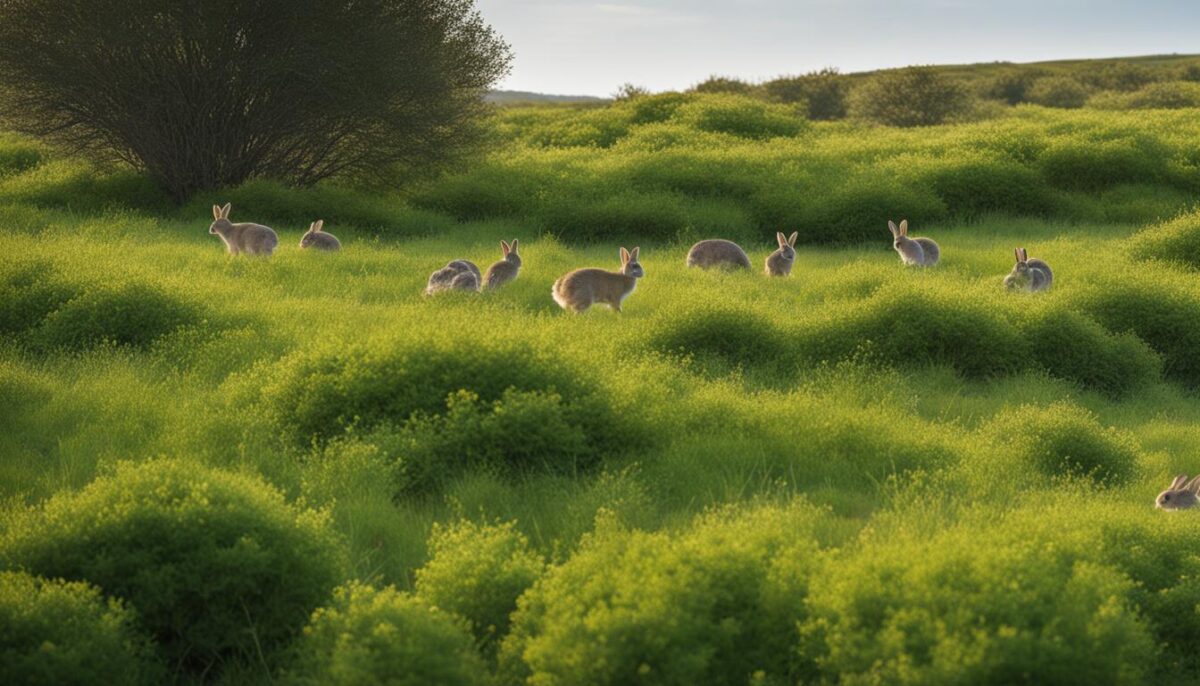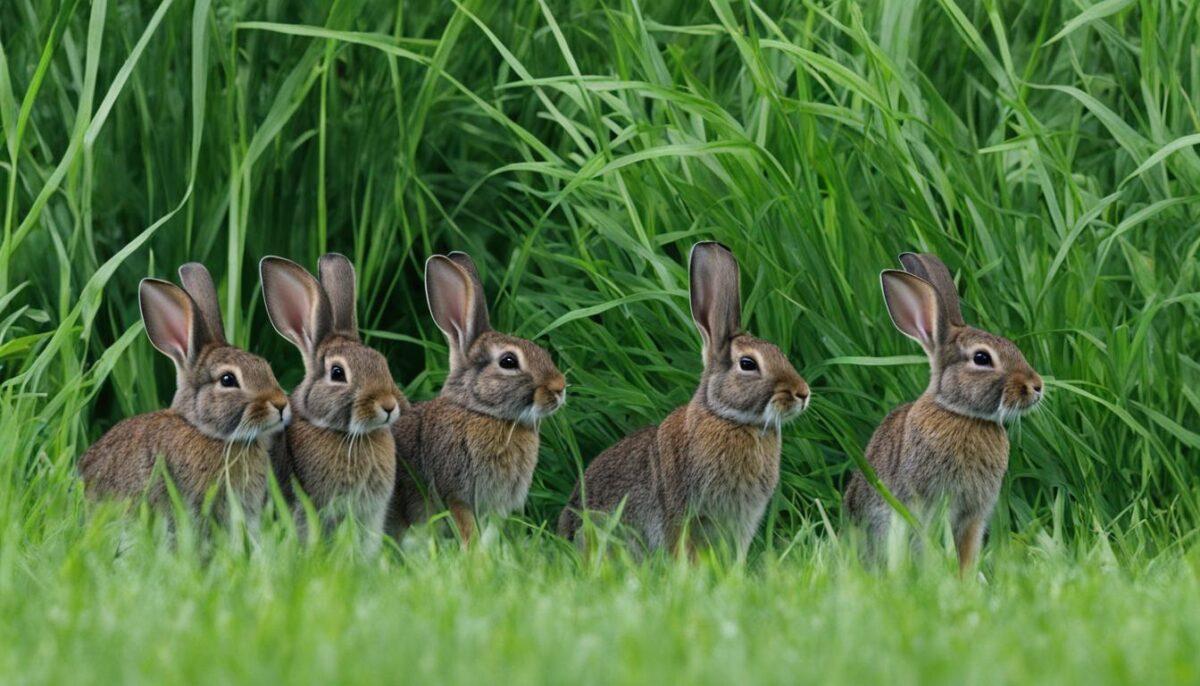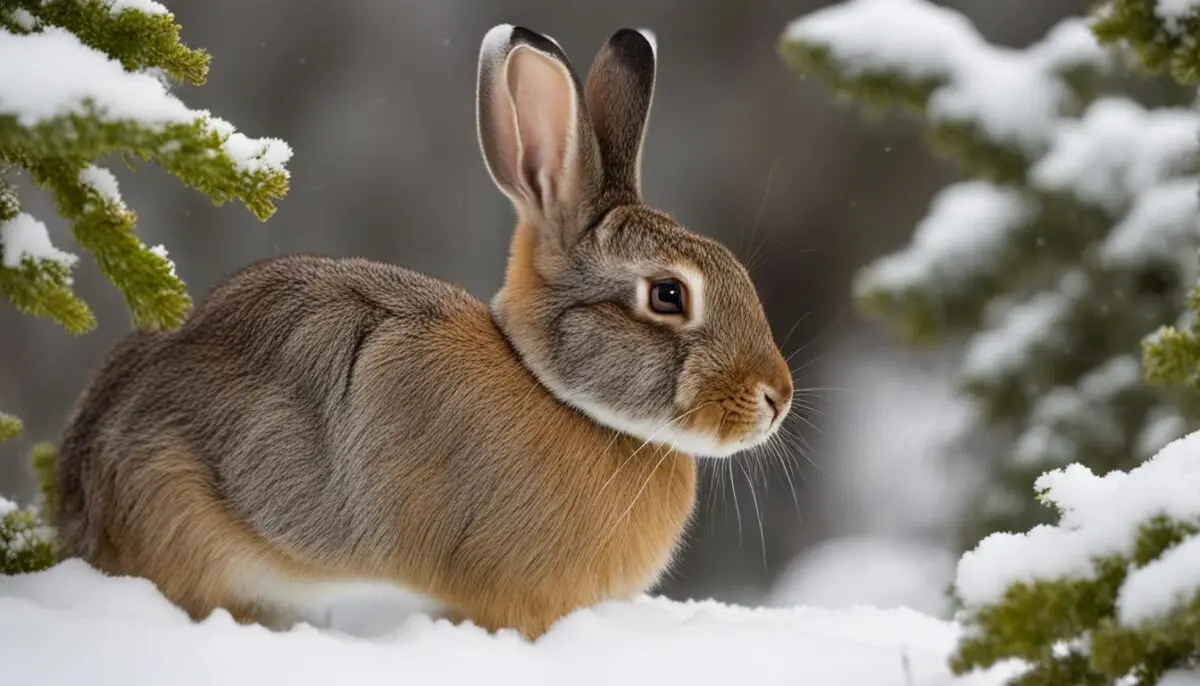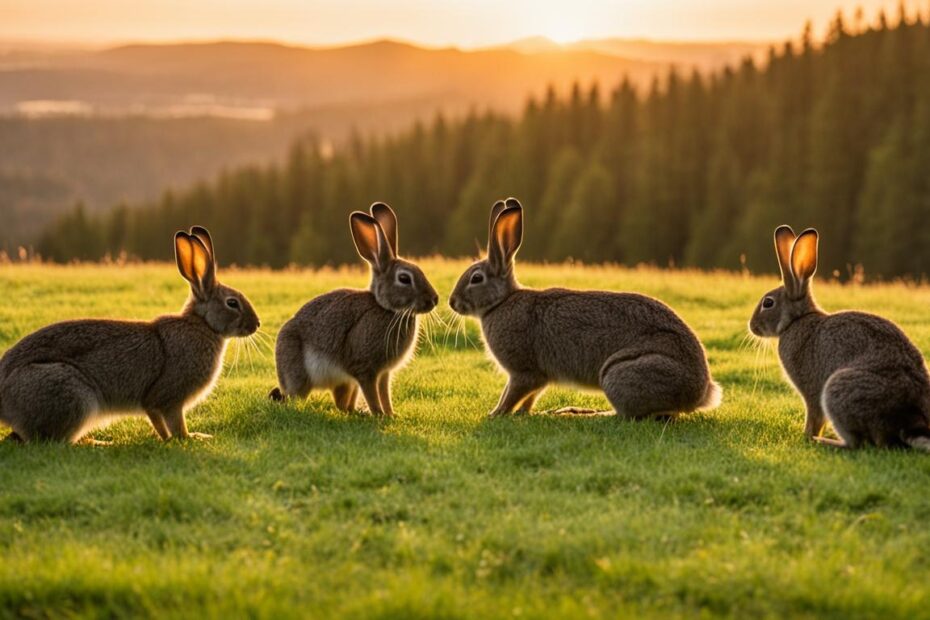Welcome to our guide on wild rabbits in Michigan! Michigan is home to a diverse range of wildlife, including several species of rabbits. One species that is particularly abundant throughout the state is the eastern cottontail rabbit. In this article, we will explore the habits and habitats of wild rabbits in Michigan, providing you with valuable insights into their behavior, habitat requirements, and more.
Key Takeaways:
- Eastern cottontail rabbits are the most common rabbit species in Michigan.
- They are found in a variety of habitats, including fields, forests, wetlands, hayfields, and orchards.
- Eastern cottontails require a mix of food and cover throughout the year to thrive.
- They communicate through various sounds, including cries of worry and squeals during mating.
- Understanding their habitat requirements can help in managing and creating suitable habitats for wild rabbits in Michigan.
Eastern Cottontail Rabbits in Michigan
The eastern cottontail rabbit is the most common rabbit species in Michigan. These adaptable creatures can be found throughout the state, although they are less common in the northern regions. With their distinctive appearance and behavior, eastern cottontails are a fascinating part of Michigan’s wildlife population.

| Behavior | Description |
|---|---|
| Nocturnal Activity | Rabbits are most active during the night, especially in the early morning hours and at dusk. |
| Solitary Nature | Rabbits prefer to live and forage alone, establishing territories for themselves. |
| Escape Tactics | Rabbits use their fast jumping ability to evade predators, employing flushing, freezing, or slinking away when threatened. |
| Communication | Rabbits communicate through various sounds, including cries of worry and vocalizations during mating. |
| Spotting Tips | To spot wild rabbits, look for feeding areas with nibbled vegetation and well-worn paths in their preferred habitats. |
Wild Rabbit Habitat Requirements in Michigan
Eastern cottontail rabbits in Michigan have specific habitat requirements that are crucial for their survival and well-being. Providing suitable habitats for wild rabbits is essential for ensuring their population remains healthy and sustainable.
These rabbits require a mix of habitats to thrive, with a varied vegetation composition and ample hiding places. Areas with brush piles, thickets, and dense vegetation serve as important hiding spots and sources of cover for rabbits throughout the year. This allows them to hide from predators and feel secure in their environment.
Vegetation plays a vital role in the diet of wild rabbits in Michigan. They rely on a diverse range of plant species for nutrition, including grasses, clover, and garden vegetables during the summer months. In the winter, when food sources are limited, rabbits turn to twigs and bark from trees. Having a mixture of plant varieties ensures that rabbits have access to the necessary nutrients in different seasons.
To support the rabbit population, it is crucial to manage habitats by incorporating a mix of different vegetation types. This can include planting grasses, shrubs, and other suitable plants that provide food and cover. By creating a diverse habitat, you can help maintain a healthy and thriving rabbit population in Michigan.

Tips for Caring for Wild Rabbits in Michigan
If you encounter a wild rabbit in Michigan and feel compelled to help, it’s important to approach the situation with caution. Wild rabbits are best left in their natural habitats whenever possible. However, if you come across an injured or orphaned rabbit, here are some tips for providing temporary care until you can transfer it to a wildlife rehabilitator:
- Wear gloves to protect yourself from potential diseases or parasites.
- Place the rabbit in a small box or carrier lined with soft bedding material.
- Provide fresh water in a shallow dish and a small amount of fresh greens or hay for food.
- Keep the rabbit in a warm, quiet, and dark area to minimize stress.
- Contact a local wildlife rehabilitator or veterinarian as soon as possible for further guidance and assistance.
Remember, wild rabbits are best left in the care of professionals who have the knowledge and resources to provide them with appropriate care and rehabilitation.
Reproduction and Life Cycle of Wild Rabbits in Michigan
Eastern cottontail rabbits in Michigan begin their mating season as early as February and continue through September. During courtship, these rabbits engage in various behaviors such as racing, jumping, fighting, squealing, and kicking. The courtship rituals are essential for establishing dominance and attracting mates.
Females can have three to four litters in a year, with each litter consisting of four to five young rabbits, known as kits. The survival of these young rabbits depends heavily on the availability of food and shelter within their habitat. It is crucial for the rabbit population to have access to suitable resources to ensure the well-being of the offspring.
Eastern cottontails are capable of breeding at a young age, with some individuals initiating reproductive activities in their first year of life. This early breeding behavior contributes to the rapid growth of the rabbit population. However, the lifespan of eastern cottontails in the wild is typically around 3 years, as they face numerous challenges, including predation, disease, and competition for resources.

Understanding the reproductive patterns and life cycle of wild rabbits in Michigan is crucial for conservation efforts and effective wildlife management. By ensuring the availability of suitable habitats and resources, we can support the population growth and overall well-being of these fascinating creatures.
Seasonal Foods for Wild Rabbits in Michigan
The diet of eastern cottontail rabbits in Michigan varies with the seasons. Understanding the seasonal food preferences of rabbits can help in managing their habitats and food sources. Here is a breakdown of the different food sources rabbits rely on throughout the year:
Winter:
- In the winter, when food sources are limited, rabbits may eat:
- Raspberry twigs
- Rose stems
- Sumac bark
Spring and Summer:
- In the spring and summer, rabbits rely on:
- Grasses
- Legumes
- Green plantlife
- Dandelions
- Domestic garden vegetables
Autumn:
- In the autumn, there is a shift to cultivated crops and other food sources, including:
- Corn
- Soybeans
- Apples
- Fruits
- Clovers, which stay green late into the fall
By understanding these seasonal food preferences, land managers and wildlife enthusiasts can ensure that the habitats of wild rabbits in Michigan support the necessary food sources throughout the year.

In addition to providing food sources, it is important to maintain a diverse mix of habitats, including woodlots, brushlands, and grasslands, to support the thriving rabbit population in Michigan.
Creating Suitable Habitat for Wild Rabbits in Michigan
Creating suitable habitat for wild rabbits in Michigan is essential for supporting their populations. A key aspect of rabbit habitat is the presence of edge habitat, characterized by a mix of woodlots, brushlands, and grasslands. This diverse landscape provides rabbits with the necessary resources for survival. Additionally, providing a consistent and diverse food supply throughout the year is crucial.
An adequate source of year-round food is vital for supporting rabbit populations. This includes a variety of vegetation such as shrubs, grasses, legumes, and grain plots. By planting these food sources next to cover, such as woodlots, brush piles, and shrub thickets, rabbits can easily access both food and shelter.
Increase the cover available for rabbits by creating buffer strips between food sources and woodlots. These strips, planted with grasses or low-growing shrubs, provide additional cover and protection for rabbits. Furthermore, allowing fallow croplands to develop brush can provide excellent habitat for rabbits, as they can utilize the dense vegetation for cover and foraging.
Recommended Plants for Wild Rabbit Habitat in Michigan
| Plant Type | Common Varieties |
|---|---|
| Shrubs | Lilac, Elderberry, Raspberry, Dogwood |
| Grasses | Timothy Grass, Kentucky Bluegrass, Orchard Grass |
| Legumes | White Clover, Red Clover, Alfalfa |
| Grain Plots | Corn, Soybeans, Oats |
By incorporating these recommended plants into the habitat, you can provide a diverse and abundant food source for wild rabbits in Michigan.
“Creating suitable habitat for wild rabbits is essential for supporting their populations and ensuring their continued presence in Michigan.” – Wildlife Conservation Society
Conclusion
Michigan is home to a thriving population of wild rabbits, particularly the eastern cottontail species. These adaptable creatures can be found in a variety of habitats throughout the state, from meadows and orchards to farmlands and brush piles. By understanding their behavior and habitat requirements, we can take steps to manage and create suitable environments for these fascinating animals.
Managing habitats that provide a mix of edge habitats, plentiful food sources, and ample cover is essential for supporting healthy populations of wild rabbits in Michigan. This includes maintaining woodlots, brushlands, and grasslands to create edge habitat, and planting grasses and buffer strips to increase cover. Ensuring a year-round supply of food such as shrubs, grasses, legumes, and grain plots can also greatly benefit rabbit populations.
By implementing these strategies, we can support the well-being of Michigan’s wildlife and contribute to the preservation of the diverse rabbit species in the state. With a careful balance of habitat management and conservation efforts, we can continue to enjoy the presence of wild rabbits and appreciate their important role in the local ecosystem.
FAQ
Where can wild rabbits be found in Michigan?
Wild rabbits, particularly eastern cottontail rabbits, are commonly found throughout Michigan. They are most abundant in southern Michigan, where there is a mix of habitats including fields, forests, wetlands, hayfields, and orchards.
What is the most common rabbit species in Michigan?
The eastern cottontail rabbit is the most common rabbit species in Michigan. It is found throughout the state but is less common in the northern portions.
What is the behavior of wild rabbits in Michigan?
Wild rabbits in Michigan are primarily active during the night, especially in the early morning hours and at dusk. They are solitary animals and are known for their ability to escape predators through their fast, jumping form of locomotion. When threatened, rabbits may flush, freeze, or slink to avoid danger. They also communicate through various sounds.
What are the habitat requirements for wild rabbits in Michigan?
Wild rabbits in Michigan require a mix of habitats to thrive. They need areas with ample vegetation and hiding places such as brush piles and thickets. This provides them with food and cover throughout the year. They rely on a variety of plant species for nutrition.
What is the reproduction and life cycle of wild rabbits in Michigan?
Wild rabbits in Michigan begin mating as early as February and can continue through September. Courtship involves racing, jumping, fighting, squealing, and kicking. Females can have three to four litters a year, with each litter consisting of four to five young. The survival of the young rabbits depends on the availability of food and shelter within their habitat.
What do wild rabbits in Michigan eat?
The diet of wild rabbits in Michigan varies with the seasons. In the winter, they may eat woody plants such as raspberry twigs, rose stems, and sumac bark. In the spring and summer, they rely on grasses, legumes, and green plant life. In the autumn, they shift to cultivated crops like corn, soybeans, apples, and fruits.
How can suitable habitat be created for wild rabbits in Michigan?
Creating suitable habitat for wild rabbits in Michigan involves maintaining a large amount of edge habitat, which includes a mix of woodlots, brushlands, and grasslands. Providing an adequate source of year-round food next to cover is important for supporting rabbit populations. Planting grasses and creating buffer strips between food sources and woodlots can help increase cover for rabbits.
Are wild rabbits abundant in Michigan?
Yes, wild rabbits, particularly eastern cottontail rabbits, are abundant in Michigan and can be found in a variety of habitats throughout the state.


